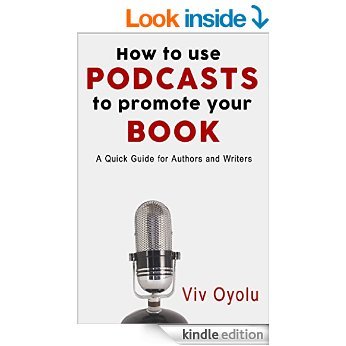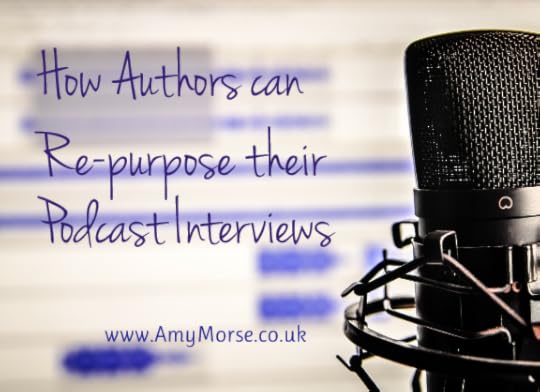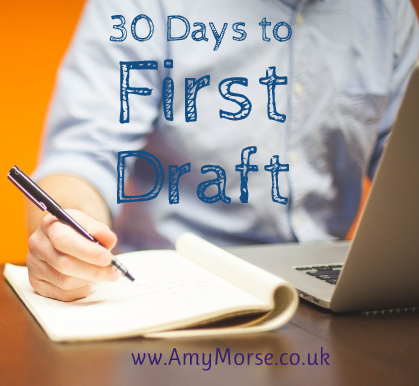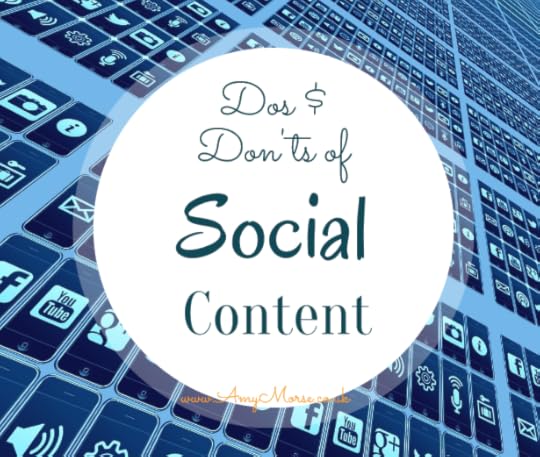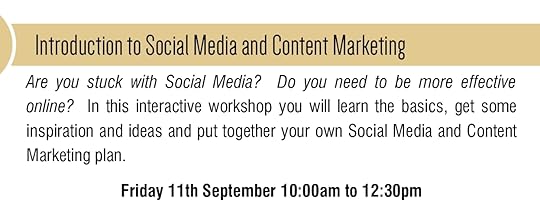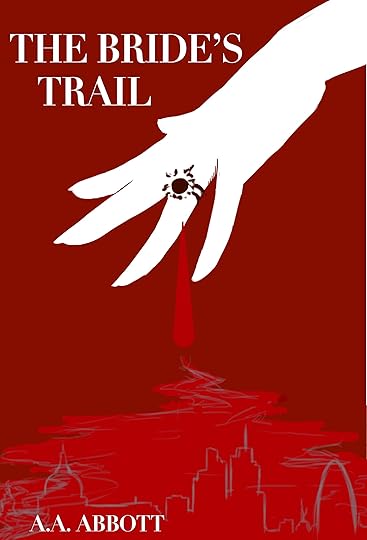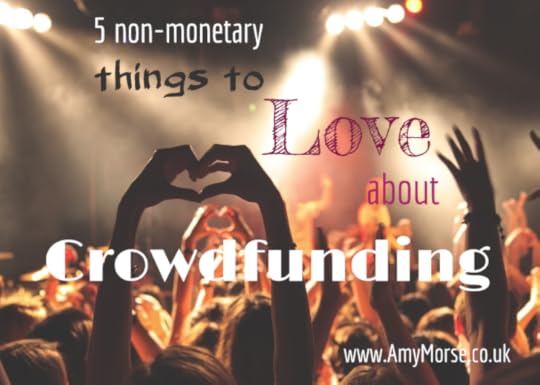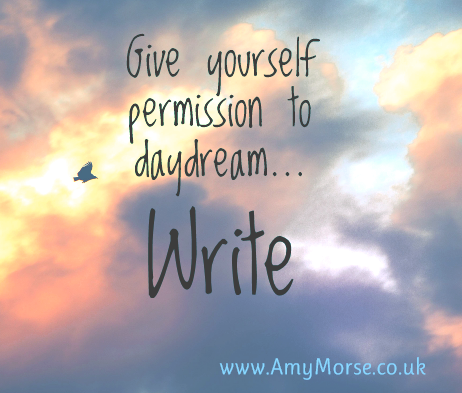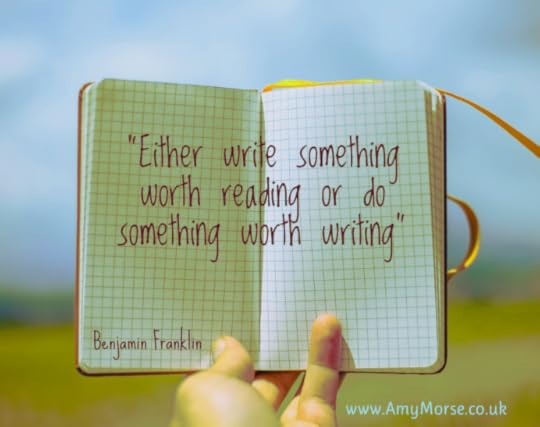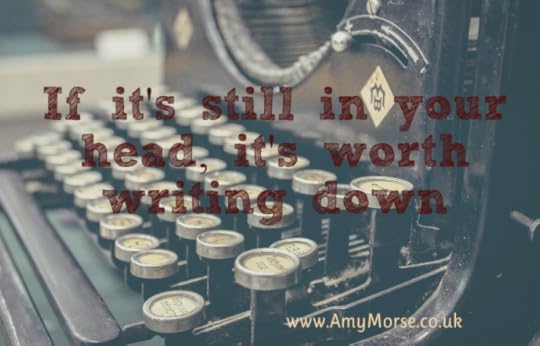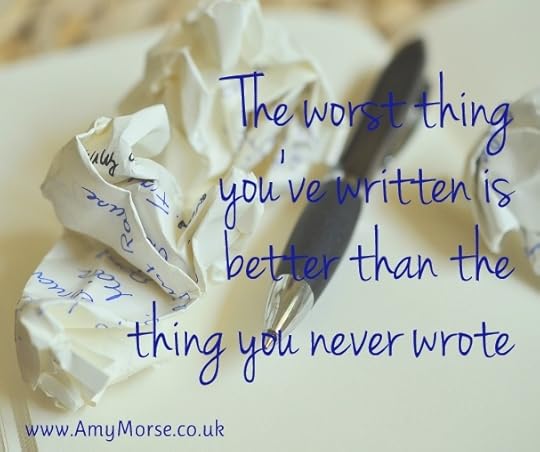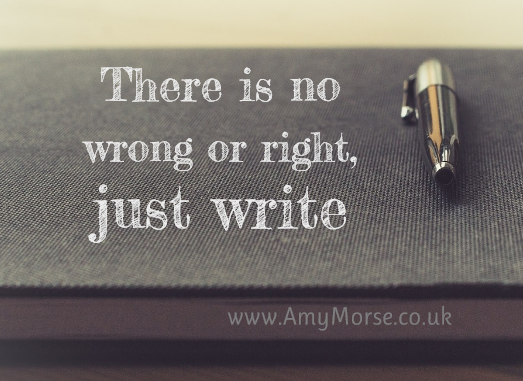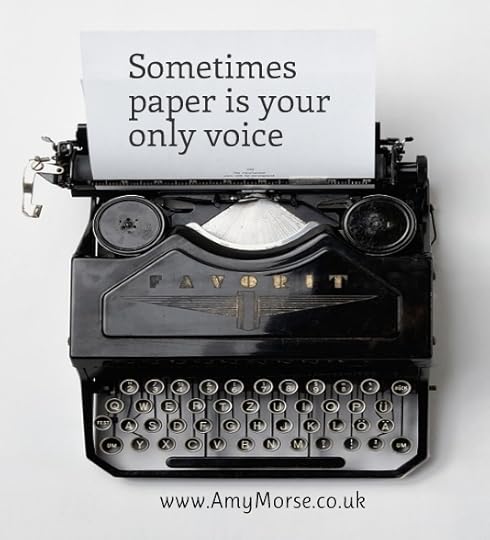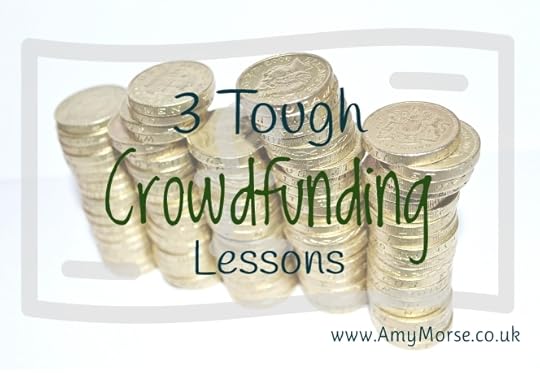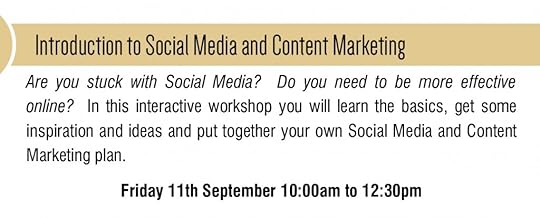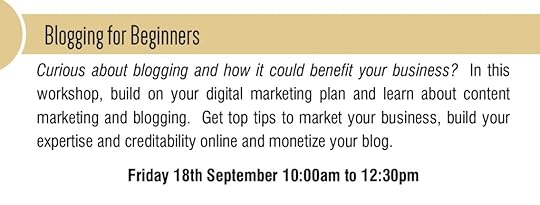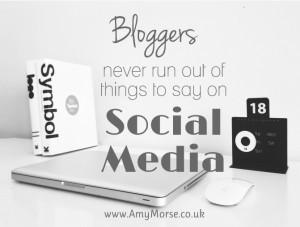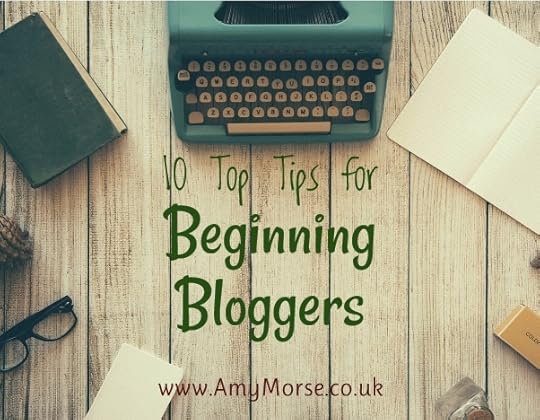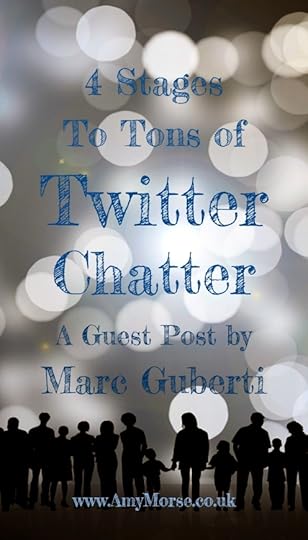Amy C. Fitzjohn's Blog, page 37
September 8, 2015
How Authors Can Re-purpose their Podcast Interviews – A Guest Post
This week, it give me great pleasure to share with you a guest post by the wonderful and inspiring Viv Oyolu.
Viv is an audio marketing expert, and has interviewed me twice now. I love her easy conversational style.
Here was my first interview with her where I talked about how Pinterest can be a powerful tool for writers:
And more recently, this is the full interview about my journey into writing and business:
Viv has worked in marketing for 20 years, had her own radio show and now works with authors.
She has also been featured the Sunday Telegraph as an inspiring woman.
Viv specializes in book marketing audio strategies for authors to increase online visibility and engagement. She has also recently published; ‘How to use podcasts to promote your book‘.
Here are Viv’s top tips to re-purpose your audio content:
How Authors can Re-purpose their Podcast InterviewsOne of the reasons I advocate for authors and writers to secure podcast interviews to promote their book, is because they can re-purpose the interviews in different ways, creating additional content that increases their visibility and connect with readers.
Since writing the ‘How to use podcasts to promote your book’, I have received comments from authors about the prospect of podcast interviews! It seems everyone ‘hates’ the sound of their voice!
If you are reading this and nodding, my advice is two-fold: You use your voice everyday – over the phone etc. Nobody has ever told you you sound ‘funny’ or ‘weird’; and that’s because you don’t. Secondly, getting ‘familiar’ with your voice takes practice. I would recommend recording yourself on your phone and playing it back to yourself. This will build your confidence and you start booking interviews to promote your book.
Re-purposing your interviews gives you content like I mentioned before, but it will only be valuable for you and to your audience if you plan ahead. As you outline your book marketing strategy, you need to be clear about what you want to achieve with your interviews.
You should decide which interviews will promote aspects of your book; and or which will promote you as an author and your author brand. There’s a difference. One is targeted specifically to niche audience with certain aspects that will appeal to them; and the other is more general – you are raising awareness about you and what you are like as an author. One interview can’t achieve both objectives.
In this post, I’ll give an example of how you can repurpose an interview, based on an interview I did with Amy Morse. Amy wanted to talk about herself as an author and raise awareness of how she works with other creative writers as an entrepreneur.
Since our interview was bespoke (Amy hired me to record the interview), we scheduled a brief chat so I could ask her what she wanted to achieve with the interview and I could prepare the right questions. Admittedly, this will be different when you are going on someone else’s podcast; but when you’ve planned properly – narrowed down your message – i.e. the key aspects you want to talk about and matched them to the relevant podcast shows, you will find gems of content within the overall interview that you can use to draw readers into you, your book and your author brand.
Back to Amy….
While Amy had the questions ahead of our interview, the interview was far from stilted. Amy had a lot more to say about herself and the interview captures her as an author and entrepreneur, as well as her personality which will endear her to new and existing readers.
The interview lasted just over 30 mins which is about standard for most podcast interviews; and out of it, I have pulled out 3 parts to illustrate how she can re-purpose her interview.
(a) Who Amy is and how she started writing
This clip is less than 4 mins long and Amy can use this to attract new readers and show her journey into writing. Many readers are writers and or would-be writers, so are always looking for inspiration – for someone who they can relate to and get them started on their own journey.
(b) What ’ s Amy ’ s writing process
I found Amy’s writing style fascinating! My book is non-fiction and we talk about how I didn’t realise that fiction writers are different. Amy can use this clip as a blog post for her website or as a guest post to compare different writing styles – asking her audience how they write etc.
(c) What Amy has been up to
As I mentioned at the top of this blog, Amy wanted to raise awareness of how she supports fellow creative entrepreneurs like herself. This is a potential income stream for her and because not all of her fans know this about her, it was important to talk about how she started doing this to demonstrate her expertise.
As you can see, these are just 3 clips that I have selected – there could have been more, but I thought these different aspects of Amy from the interview are a good indication of what’s possible.
You can do the same either by using a professional to record specifically or select one section from your interviews from the podcast shows you go on.
How to share your re-purposed content
We’ve used SoundCloud to share the main interview and clips which are easy to share across social media. If you don’t know about SoundCloud, the easiest way to describe it, is it’s the YouTube of audio. It’s a fantastic tool that provides a lot social media engagement – ideal for authors and writers.
SoundCloud offers 180 mins FREE use; and if you’ve been interviewed on 3 podcast shows for 30 mins each, and repurposed sections of these interviews, you still have capacity and not have to take up the paid service. You can find out at www.soundcloud.com
Hope you’ve found this useful. If you will like to find out more about how you can plan and incorporate podcast interviews in your book marketing campaign, then ‘How to use podcasts to promote your book’ provides a detailed strategy on how to plan and prepare. There’s more at: bit.ly/PromotingYourBook
A big thank you to Viv for contributing.
Audio is a great tool in your marketing toolbox and an often underutilized one. The great thing about audio marketing is that you can slip in some earbuds and feel a connection it the person speaking and you can also multitask more easily when listening to information, unlike watching a video where your main senses are both occupied. I find it a really useful way to absorb information and I would highly recommend Viv’s service and the book.
Find out about her services to authors here: http://www.theaudiomarketingexpert.com/about/
An get your copy of the excellent and accessible eBook HERE:
Connect with her on Twitter at: @AudioMktgExpert
Have you ever had an audio interview? Share your experience and links in the comments.August 25, 2015
30 Days to First Draft
Why wait for NaNoWriMo (National Novel Writing Month)? There’s no rule that says the only time you can try to write a novel in a month must be November.
I knew that August would be a fairly quiet month for me and I really want to get the last book in the Sheridan and Blake Adventure Series written so I set myself the challenge of completing the first draft of ‘Garbriel’s Game, Part 2: The Black Knight’ by the end of August.
The first part of the final book in the series, ‘Garbriel’s Game, Part 1: The White Queen’ came out a few weeks ago.
I have already written some of part 2, my characters are firmly embedded; Tom Sheridan and Sasha Blake have been living in my brain for the past 4 years and I already know how their story ends, I just need to let them stretch their legs on the page.
I’ve written before about goal setting, I’m a great believer in it
http://ideaism.blogspot.co.uk/2015/01/ten-reasons-to-train-yourself-to-be.html
I’m also a great believer in a personal challenge, but when you embark on a mighty project like this, it’s important to do so with your eyes open.
Here are my 9 tips to help you write a first draft in 30 days
Decide what your target is, then divide it by the number of days to set yourself a daily goal. In my case, I want to write 30,000 words = 1,000 words a day Just write. Even if you churn out a load of rubbish, that’s fine – no writing is ever wasted. The more you write, the better you’ll get at it. It’s okay to take chunks out. It’s disheartening to reach a word count target, then the next day go backwards. Don’t fret, you can use the words you chopped out for another project, save them in a scrapbook folder somewhere on your computer and keep going, it won’t take you long to catch up on yourself and your writing will be better for it. Ignore the red squiggles (or switch them off). Get to a good place to stop, ie: end of a chapter; before you worry about going back and correcting things. I’ve seen other advice suggest you write with the monitor off or don’t change any spelling, typing and grammatical errors until the very end. Personally, that does my head in. Each day when I start writing I self edit the chapter I’m picking up from as a way to help me get back into the narrative. Have a plan. You don’t have to slavishly stick to it, but at least prepare some sort of narrative plan, character sketches and a story arc before you start writing. If you’re setting out on any journey, you always need to have some idea of the destination or direction to take. It doesn’t have to be linear. This might be tough to get your head around, but you don’t have to start at the beginning and plod through in the order the story will eventually be in. Perhaps there is a scene you are desperate to write but it doesn’t happen until half way through. So what… just write it and get it out of your system. Perhaps you hit a block and don’t know what comes next? That’s fine, pick another scene and write that instead, it may even help you see a path from where you left off to where it reconnects. Protect your writing time. Ahead of the month, go through your diary and block out the time you need then jealously guard it, don’t let anything else get in your way. Communicate. If making time in you schedule will impact others ie: your partner or the children, make sure you communicate with them and give them plenty of notice. Ask them to respect the time you need to complete this project, plan ahead to make alternative arrangements for example, do you really need to be the one to run that errand at that time or can you combine it with another errand, do it another time or delegate it to someone else? Be realistic. If you can’t make the time you need to reach that word count goal, set a more achievable goal. Always overestimate how long something will take you. If you think it will take an hour, allow an hour and a half, giving yourself a break and a little leeway will keep you motivated. Here are some other links from around the web with some tips to get your going: Natasha Lester has shared 5 tips on her blog to fit writing into your life HERE If you’re feeling really ambitious, Sprint Shack has tips to write 10,000 words a day HERE The Write Practice has 4 ways to fit more writing in HEREWhy is August a better time than November? The keen eyed among you will have spotted my reference to 30 days to first draft – that’s a bonus extra day in August!
As I approach the end of the month, I must confess, I am behind on my word count but I’m quietly confident that I can finish the first draft of ‘Garbriel’s Game, Part 2: The Black Knight’ at the start of September and I’ll be very happy with that!
Good luck!
August 14, 2015
The Dos and Don’ts of Social Content
Social Media has evolved from a way to chat on line to an integral part of the marketing and communications process for businesses. A common issue that my clients raise with me is not so much; why and how Social Media can benefit their business, but what they should be talking about online? What’s the etiquette? What makes a good Social Media post?
Social Media can be a powerful and effective way to tell your story, share valuable content and build a fan base. It doesn’t have to take up all your time, as long as you have a plan and allocate some regular short bursts of time, it can make a real difference to the reputation and therefore success of your business.
DoKnow your audience. Who are your customers and what do they want from you? This is at the heart of your marketing.
Be where your audience are. Use platforms that your customers use. If your customers aren’t on Twitter but they do use Facebook, focus your energy on being on a platform they will see.
Follow and learn from your competitors. Your competitors aren’t necessarily your enemy. Share their content, refer people to them and maintain good relations, you never know what lucrative opportunities to collaborate may come up.
Genuinely compliment others. Say nice things about other people and they’ll say nice things about you – this is the power of word of mouth and Social Media can give it a megaphone!
Be present. If you are going to use Social Media you need to be a regular and consistent attender. A feed that hardly ever gets updated isn’t worth following. You don’t need to be there 24/7, just dip in regularly, plan and schedule posts in advance. Studies show that 3 tweets a day reach 30% of your audience.
Be generous with your knowledge, information and expertise. Don’t give away everything for free but if you can show that you have expertise and make your customers feel like they’re getting a freebie, they’re far more likely to take the next step and buy your product or service because you’ve established your credibility.
Optimize your feed by following relevant people in your industry, customers, competitors and influencers. If you don’t want to fill your feed with celebrity gossip, don’t follow celebrities! Stay relevant and share liberally
Be polite. All the usual social graces apply – remember your manners. Thank people, ask with a ‘please’ and always acknowledge the contribution of others openly.
Don’tsConstantly saying ‘Buy My Product’. There is an 80/20 rule with Social Media. 80% of your content should be promoting other people, sharing useful information and saying nice things about other people and 20% self promotion. Once in a while it’s fine to say ‘Buy My Product’, but do so in a helpful way to avoid turning people off. For example; ‘Here are my top X tips on Y, to find out more buy this eBook’ etc. Or, ‘the new range is out now’ – people who do like your product will want to know this.
Be publicly nasty to someone else. There’s a word for this; ‘trolling’. Be courteous, you might be online but you’re still in the real world. If you openly and personally attack others online all you do is make yourself look bad. Call people out if they get their facts wrong, disagree with people – absolutely, but do so in a constructive manner. The best piece of advice my mum ever gave to me was ‘treat other people how you would wish to be treated yourself’.
Engage trolls. The best thing to do if someone attacks you online is to report the abuse and ignore it. Bullies want a reaction from you. If you give them what they want it can quickly spiral out of control. Walk away!
Ignore complaints. While you should ignore trolls; if a customer complains publicly online, as with any customer complaint, you need to respond quickly and positively. Remind yourself; a complaint is not a personal slight (although it can feel that way when it’s your own business) but an opportunity to improve. Take it offline and find out from the customer what they feel would be a fair way to resolve the issue.
Think of it as a sales tool. Social Media does not sell your product. It’s a communication channel, nothing more. It’s important but it’s by no means the all powerful solution that some may suggest. It’s ONE tool in your marketing tool box; a communication tool. But if you don’t have something worth communicating then it is of no value to your business.
If you would like to learn more about how to effectively use Social Media to promote your business, come to this workshop in Bristol in September:
http://www.eventbrite.co.uk/e/introduction-to-social-media-and-content-marketing-tickets-17807021280
August 4, 2015
Team Work is Dream Work
It gives me great pleasure to share another guest post with you this week.
Crime fiction writer, Helen, alias; AA Abbott.

Bristol Crime Author; AA Abbott
Her post really resonates with me and I hope it inspires you too.
As a business coach and an independent writer, I agree that one of the keys to success in business is to have a good team around you. I don’t necessarily mean hiring staff; but recognising that you can’t do it all yourself and if you try there will inevitably bits you don’t do well, hate doing, or take you forever because you don’t have experience. This is where working with good people; to fill gaps, support you and do the stuff you can’t do, hate doing or don’t have time to do – can make the difference between scraping along and exceeding your expectations of success.
Over to AA Abbott…
Teamwork is Dreamwork, says crime thriller writer AA AbbottI write blockbuster-style crime thrillers and publish them myself. Why? I’ve always adored a good story, I have fun writing a book I’d like to read, and the digital age means a thriller can be on sale across the world at the press of a button. That instant gratification is incredibly satisfying.
I don’t do everything myself, though. There’s a great team supporting me, and my books are better for it. That’s real synergy: together, we exceed the sum of our parts (Tweet this)
You may ask, “How is this relevant to me?” In truth, you’ll often find yourself in a situation where you either have to rely on others or will achieve a better outcome if you do. Are you in business, for instance? You may well use specialists to carry out tasks for you – whether that’s doing the books, printing business cards, or repairing the company van. If you have a medical emergency, you’ll go to the doctor, and if you’re organising a wedding, you’ll have a whole army of helpers. Writers are no different. When I publish my own books, like Amy, who kindly hosted this blog, I’m an entrepreneur. A support network is crucial.
My team starts with readers. Twenty readers go through my draft thrillers from beginning to end. (In the publishing world, the technical term is “beta readers”.) They tell me if I’ve got it right. Invariably, I’ll sit down at my keyboard and make changes after I’ve listened to them. For my latest thriller, The Bride’s Trail, I was lucky, too, to secure the services of editor Katharine D’Souza. She also writes novels, and I love her books. She made thoughtful suggestions for improvement and I believe The Bride’s Trail is even more readable as a result.
Daydreaming about a story and committing it to paper is intuitive for me. Marketing isn’t. Fortunately, two brilliant Brummies do most of mine. Donna Marie Finn arranges everything from press releases to live fiction events to book launches. If you’re in Birmingham on 24th August, do come along for champagne and roulette at the Grosvenor casino! (Book free tickets here). The venue resonates with the theme of the book, as The Bride’s Trail is about a croupier who disappears.
Twitter guru David Massey was responsible for the name of the book and the crucial cover design, while Westminster art graduate Sofia Wilson then created it. Some multi-talented authors are artists too, but alas, I’m not one of them.
While the beta readers give their time for free (thanks, guys! You’re awesome), other services have to be paid for out of the profits I make from publishing. I regard it as a worthwhile investment. Thanks to my team, my books are as good as they can possibly be, and they’re in front of a wider audience.
Of course, I’ve benefited too from a wider network of friends, writers and business contacts (like Bristol Fiction Writers’ chair Suzanna Stanbury), who have shared time and tips freely. With their help, I’ve not been daunted by printing paperbacks or by listing e-books on Amazon. Also, when I‘ve had to spend money, I’ve done it wisely. Again, anyone in business needs a network – I’d go so far as to say it’s the key to success.
So, there you have it – I’m enjoying the relief and excitement of sending another cracking crime thriller into the world, and the icing on the cake is gratitude to everyone who made it happen!
Crime thriller The Bride’s Trail is available through bookshops and Amazon, on special offer at £1.99 e-book and £7.99 paperback until 31st August. AA Abbott has also written After The Interview and Up In Smoke , and a number of short stories.
Find AA Abbott at aaabbott.co.uk (sign up for infrequent newsletters and receive a free e-book), on Facebook and Twitter .
Get AA Abbott’s books HERE
Thanks to Helen (AKA AA Abbott)
If you’re interested in contributing a guest post please get in touch: amy@tomcatdesigns.co.uk
August 1, 2015
Help Bring Literature to Life in Bristol
From October 15th to 24th 2015 is the fifth Bristol Festival of Literature.
This year I’m on the organising committee. This citywide community festival is run entirety by volunteers and we receive no funding for it, but putting on an event of this magnitude costs money.
This year the festival is raising funds through a crowdfund.
Here it is – please pledge and share:
I’ve run my own crowdfund in the past to publish Solomon’s Secrets and at the time I wrote a guest blog for Bristol Books Blog, HERE.
A couple of writer friends of mine on the festival team have had experience of it too.
I recently featured a Guest Post by Richard Jones of Tangent Books on his recent fund.
I’m a big fan of crowdfunding, and I’m a big fan of the Bristol start up Fundsurfer who we’ve all used for our crowdfunds.
I’m now a Fundsurfer partner and happy to answer questions on the topic and help if I can.
Here are 5 non-monetary things I love about Crowdfunding:
Building Community. You can mobilse the support of your fan base and give them a hook to share with their networks Social Proof. It’s a very public way of showing that people support what you are trying to achieve Marketing Platform. It’s a great excuse to embark on a sustained marketing campaign to raise awareness. Newsworthy. A crowdfund is a newsworthy activity and makes better editorial copy than an advertisement Telling Your Story. People don’t just buy people, they buy stories. A crowdfund campaign can provide a great platform to share your story and engage peopleSupport Bristol Festival of Literature by sharing this link to the crowdfund:
https://www.fundsurfer.com/project/bristol-festival-of-literature
Follow on Twitter: @BristolLitFest
Use the hashtag: #Unputdownable2015
July 25, 2015
No excuses… just write!
I have always had a side business while working and only now am I fully self employed and dependent on my own entrepreneurship to make a living.
It’s both a scary and exciting time.
In the space of a few moment I swing from;
“This is fantastic, I love working for myself…”
to
“This is a terrible idea, how do you ever hope to make this work?”
The thing is; we all need these moments of doubt and moments of supreme confidence – the trick is to get them working in symphony and find that sweet spot of successful productivity.
It’s imperative to have a vision for your own business, otherwise you’re just floundering around, chasing every shiny new thing without direction or priority. All you’ll accomplish is to feed that voice of doubt; because you never seem to get anywhere.
The vision for my business is; to make enough of a living from writing that when I provide business support and do public speaking, I do it for fun. I dream of using the freedom of our digital world to be able to live and work anywhere.
But right now; my priority has to be to work on my business support business – there are bills to pay.
However, I need to remind myself that first and foremost; I’m a writer.
I’ve been spending so much of my time cultivating my business support business, that I’ve forgotten to protect my writing time.
With one final book in the Sheridan and Blake Adventure Series, I am close to the end of one writing project but need to finish it before I move on to the next.
Something that always helps me to find my mojo, is positive affirmations and inspirational quotations:
This one seems fitting as it reinforces my vision for my business…
This is one I often write inside books when I sign them for people…
This one reminds me that I can write the story in my head but I need to get it onto to the page if I want to share it…
This one reminds me that the most important thing to do, even if you don’t feel like it, even if you are in a fug of self doubt, is to just write…
This one, similarly reminds me to just write, until I show it to anyone, no one is judging it…
And finally, this one reminds me that I have to write, that it keeps me sane and that in order for me to move forward I need to empty all the bumf from my brain out onto the page…
So… now I’m going to sit down and just write!
What are your favourite motivational mantras and quotations?July 20, 2015
3 Tough Crowdfunding Lessons
I’m proud to host another guest post this week from a friend of mine and fellow organiser of Bristol Festival of Literature, Richard Jones.
Richard is one of the founders of the radical independent publisher Tangent Books, in Bristol. He’s currently in the midst of a crowdfund to reprint ‘Catacombs of Terror’
I love the irreverent style of the video and encourage you to take a look at the pitch, it’ll make you smile if nothing else.
Please share the link to and help the Tangent team reach their target. Thank you.
Share this link on Twitter: https://www.fundsurfer.com/project/catacombs-of-terror-by-stanley-donwood
I’m a big fan of crowdfunding, having successfully used it to publish ‘Solomon’s Secrets’
In his post, Richard shares some of his frustrations as an Independent publishing house and also the three tough lessons he’s learned from the the experience.
With our experience of crowdfunding, and also that of fellow writer and Bristol Festival of Literature organiser, Pete Sutton, who also recently successfully crowdfunded the publication of a short story anthology; ‘North by Southwest’
Our next crowdfunding project is to raise some money for this years Bristol Festival of Literature – we’re working on the pitch at the moment, watch this space for the launch in August.
Over to Richard…
Richard Jones – Tangent Books
3 Tough Crowdfunding LessonsI was about to start writing this piece about how crowdfunding is an opportunity to build communities that support ethical buying, when an email from Kickstarter popped into my Inbox. ‘Kickstarter Goes Social!’ Is the heading. According to the blurb ‘It’s true! If you connect with Facebook, you can follow your friends to get notified as they’re backing and launching projects. Likewise, they’ll be notified whenever you do the same…’
You’ve probably received one too if you’ve supported a Kickstarter campaign.
But let’s get the context for this piece out of the way first. Tangent Books is a radical, independent publisher based at Paintworks in Bristol. Tangent has supported many crowdfunding campaigns and appeals and has worked with at least four authors and writers’ group this year who have raised money towards publishing books via crowdfunding.
A couple of weeks ago I launched Tangent’s first crowdfunding campaign. It’s hosted by Bristol company Fundsurfer and is aimed at raising money to help fund the reprint of Stanley Donwood’s lost ‘classic’ Catacombs of Terror! You can read about some of the frustrations and politics of my experience here http://bit.ly/1V9GYnf and you can support the campaign here http://bit.ly/1HuDsOx
I’ve learned several lessons about crowdfunding in the last few weeks including.
It’s easy to get hung up on why certain people don’t want to share and pledge rather than focus your attention on the bigger picture. Crowdfunding is about more than raising money. It offers a great opportunity to promote ethical buying.Let’s concentrate on point 3. I was one of the activists in the campaign for Bristol to be granted Fairtrade City status (2005) and continue to support the Fairtrade agenda. One of the reasons I am attracted to Fairtrade is the simplicity of the message and the focus on individual responsibility.
If you like chocolate but hate Nestlé, you can buy Fairtrade in the knowledge that a larger proportion of the price goes back to the farmers, it’s a stable price for them and the Fairtrade social premium will be invested in improving working conditions and education in the farming communities.
It’s a similar story with crowdfunding, it’s entirely your choice whether you support Amazon or individual authors and publishers.
I am always surprised how ignorant people are of the consequences of buying books on Amazon. Amazon takes 60 per cent of the cost of a book from publishers signed up to its Advantage programme. The publisher also has to pay to ship the book to Amazon, so the actual discount is closer to 65 per cent.
The traditional discount to retail was 35 per cent under the Net Book Agreement. It’s now at least 40 per cent. Many authors’ contracts state that they don’t receive royalties if the discount is greater than 65 per cent, so they don’t get anything from Amazon sales. Those that do get a payment, get a pittance.
The price Amazon pays is very close to the cost price if a UK publisher prefers to print locally (in Britain and Europe). In order to achieve prices that make it viable to sell on Amazon, many publishers choose to print in countries where there are serious concerns over the wages paid to print workers, where there is evidence of dangerous working conditions and where pollution from the print industry is a major issue.
The vast majority of people don’t care about any of the above and are driven by price and convenience. Tangent sells a lot of books on Amazon, but has amended contracts to protect authors as best it can and prints as locally as possible.
Back to the Stanley Donwood campaign… we probably over complicated it by inventing a back story and producing a video to support it, but it was great fun and those people who ‘get it’ really like it. The rest are confused.
So that’s another lesson – KISS (keep it simple, stupid).
But I’m already looking at the opportunities for the next Tangent crowdfunding campaign and it’s highly likely it will be about building a community around ethical publishing rather than about the book itself. So whatever the book, the focus will be supporting the author and publisher by avoiding Amazon and supporting local print.
I can’t wait! But I need to get this one funded first and with your help, I can.
Thanks for contributing Richard, and good luck with the ‘Catacombs of Terror’ crowdfund.
Find out more about Tangent Books at their website: www.TangentBooks.co.uk
You can stay in touch with Richard here; richard@tangentbooks.co.uk
Or follow on Twitter: @TangentBooks
July 17, 2015
Curious about Content Marketing and Blogging? Find out more…
When you work for yourself it can be lonely. We don’t get the stimulus and creative input we would from being around like minded people. In our increasingly connected world, it’s impossible to run a business in isolation, we need others to thrive; without customers, you have no business.
While we can read content online, chat on social media and do online courses, sometimes there is no substitute for some real world interaction. Even introverts need some human contact.
We can learn so much from reading information, but without others to bring it to life, share ideas, inspiration and opinions with; it’s a 2 dimensional experience.
I’ve been a professional trainer for the past… (I hate to admit this, it makes me feel old) …15 years. I now work for myself and I’m passionate about supporting others to follow their dreams. In my case, it’s working for myself and writing.
I am running 2 complementary workshops in September 2015 on:
Introduction to Social Media and Content Marketing Blogging for BeginnersAt: The Factory Meeting Room – The Tobacco Factory, Raleigh Road, Bristol, BS3 1TF
Introduction to Social Media and Content Marketing
Blogging for BeginnersThe workshops feed neatly into each other.
£40 each or £70 for both
(Includes tea, coffee and cake!)
To book email me: Amy@tomcatdesigns.co.uk
Or book via Eventbrite
It’s not necessary for you to be a business to benefit from these workshops.
Network with others, invest in yourself, invest in your business.July 14, 2015
Blogging for Beginners: 10 Top Tips
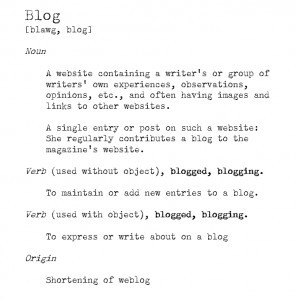 Blogging is one of the most simple and immediate ways to demonstrate your style, expertise and share knowledge.
Blogging is one of the most simple and immediate ways to demonstrate your style, expertise and share knowledge.
Bloggers never run out of things to say on Social Media.
There are different ways you can venture into the world of blogging; you could use an online blogging platform such as blogger.com or bloglovin.com or you could host your blog on your website.
There are advantages and disadvantages to both.
If you are new to blogging. A good way to start could be to play around on the free online platforms for a while and when you get more comfortable and confident, then have your blog on your website.
Bloggers never run out of things to say on Social Media (Tweet This) Here’s my top 10 tips for beginning bloggers: Have a theme. Choose something that is appealing to your customers and have a consistent theme throughout. We’re all interested in lots of topics, especially writers and creatives, we’re naturally curious and observant, but the aim is to build a fan base and a following, not to get lots of people who are mildly interested in some of your stuff, then switch off and forget about you without buying your product/service.Blog regularly and consistently. Don’t fall into the feast or famine trap – build blogging into your regular routines. For example; publish once a week on a Saturday. Once a week is a minimum, you don’t have to blog daily, unless you really want to, but weekly is enough to keep people engaged. The ideal is 2 – 3 posts a week at regular intervals i.e.: every 3 days publish something.
Vary the content. Keep it interesting. Have videos, audio, words, images, lists, stories, tips, questionnaires, graphs, infographics, interviews etc. There are so many different ways to present your information. A blog that is just reams of text gets stale very quickly. Break it up. Make it bite sized and not too wordy. Keep it informal, friendly and accessible and people will come back for more.
Make it easily sharable. Make sure you have social media links on it. Make use of tools like ‘click to tweet’. Create images that also have text on them, these are ideal for Pinterest, especially if your customers are woman, more women use Pinterest than any other social media platform.
Always include at least 1 image per post. Images have more impact on social media and are more likely to be shared. Also, it breaks up the look of the page making it easier on the eyes than just big blocks of text. As mentioned above, this makes your blog much more accessible for Pinterest. I (and thousands of others) use Pinterest as a way to curate links and bookmark content online for future reference, there are few things as annoying as not being able to do that with a blog post because there is no image. People will go elsewhere to find content if they don’t have a simple way to capture the link and store it for future reference.
Have a plan. Be organised. It’s easy to publish content weekly if you know what to post, it’s a nightmare if you are having to think on your feet all the time. It doesn’t have to be complicated. Use the ‘Weekly Marketing Calendar’ template to plan in days, themes and topics you will blog about. Keep adding to the plan and try to stay a step ahead so that you’re not in a panic trying to decide what to blog about.
Do plenty of research. I find Pinterest invaluable for this. I have boards where I collect tips and ideas for blogging, I have boards for book research, I have boards for writing ideas and inspiration and I have boards of other curated links I can draw on. When I come to sit down and prepare some blog content, I have plenty of sources to draw on and my biggest challenge is what to choose next. It becomes a pleasurable experience, rather than a chore when you start to build up a repository of ideas you are desperate to share with people.
Here’s my ‘Blogging Brilliance’ board with lots of great links for inspiration and tips
Follow Amy Morse – Authorpreneur’s board Blogging Brilliance on Pinterest.
Invite contributions from others. It’s a lovely thing to host someone else on your blog. It saves you having to write content for that ‘episode’, it builds relationships with others and it allows you to increase your reach by accessing other people’s networks. It can be a bit of leg work to get people to do it, however, and sometimes you may have to chase people. Don’t rely on it for your schedule, think of them as bonus content.
Last week I hosted the inspiring young entrepreneur Marc Guberti – Read his Twitter Tips HERE
Showcase other peoples work and tell them about it. Write a blog in which you share what someone else is doing, involve them, or at least tell them about it and they will share it too, allowing you to access wider networks. It’s an easy way to guarantee shares on social media etc. Encouraging others to share is the only way you’ll get any content to go viral. Also, if you say nice things about other people, they’ll say nice things about you and that’s the key to spreading your message through word of mouth.
Social media and blogging were made for each other. If you are sharing knowledge, imparting wisdom, showcasing other people’s work, all of that is social media gold dust.
I’m giving a short talk at ‘Sole Traders United’ meet up group in Bristol on Thursday 16th July at Falafel King, Cotham. Find out more and book in HERE
If you would like to learn more about the art of blogging and how you could use it in your business, I’m running a ‘Blogging for Beginners’ workshop on Friday 18th September at The Tobacco Factory, Bedminster, Bristol.
Email me for details and to book a place: amy@tomcatdesigns.co.uk
July 6, 2015
4 Ways to Get More Twitter Chatter – A Guest Post
It gives me great pleasure to welcome back the very talented teenaged entrepreneur Marc Guberti.
Marc wrote a guest post for Idea’ism in November 2014 on top tips to make better use of your time. You can read it here here: http://bit.ly/MGuberti_TimeMngmt
Marc is a prolific writer and is highly successful on Social Media.
Here are his 4 stages for having more conversations on Twitter:
4 Stages To Having Tons Of Twitter ConversationsWonder how the influencers get so many opportunities from Twitter? For some influencers, their audience sizes have something to do with the opportunities they get. However, there are other influencers with smaller audiences who still get opportunities. I know several people with only a few thousand followers getting speaking engagements and appearing as columnists for high-profile magazines such as Inc and Entrepreneur.
Audience size is a small part of the equation. Don’t believe me? Take a look at the people who contribute for Inc and Entrepreneur (and others). Not all of them have massive Twitter audiences, but they write great content and know how to build healthy relationships.
Engaging in conversations allows you to better know who your audience is, and that knowledge allows you to better serve them. Having conversations can also open the door to many opportunities.
Interacting on Twitter will always be important, but there must be a flow. You must have guidelines that you go by to have a Twitter conversation to ensure that your current conversations go well and you get involved in more conversations in the future. If you want to have tons of awesome Twitter conversations, follow this four-step process.
Stage #1: Tweet High Value Content
Just because you are on Twitter does not mean people have a reason to interact with you. With hundreds of millions of people on Twitter, the way to have more conversations is to stand out with high value content that your targeted audience would be interested in.
Tweeting high value content won’t get you tons of Twitter conversations when you first start. However, as you consistently tweet high value content, more people will take notice. They will pay more attention to your tweets and decide to engage with their favorite ones.
Tweeting high value content will make it easier for people to appreciate your tweets. This first stage is necessary preparation for building upon your credibility so people will have a strong desire to interact with you.
Stage #2: Thank People For Sharing Your Content
At some point, more of your followers will take note of your high value content and start sharing it with their followers. Regardless of whether the tweet from one of your followers gives you 20 extra Twitter followers or zero extra Twitter followers, one thing is certain—the person who sent out the tweet appreciates your content and what you do.
When you see someone retweeting you or sharing one of your blog posts, it is easy to think that you have won. It is easy to think that this person will continue engaging with your content and that you have a healthy relationship with that person.
Don’t believe it. The web has given us more options than ever before. Taking some inspiration from Adrian Monk, the web’s ability to provide us with so many options is “a blessing, but a curse.” We travel across so many blogs that it is easy to forget a particular blogger we previously found interesting a few weeks later. I forget the names of some of the people whose content I share a few days later. I know because I write their names on a sticky note and remember them that way.
When someone retweets your tweet or shares one of your blog posts, thank that person. It can be as simple as saying, “Thank you for retweeting me,” or “Thank you for sharing my blog post.”
People don’t expect the “Thank You” which will make you stand out all the more. So far, I haven’t received a negative response by thanking someone, and I have thanked thousands of people for sharing my content.
Stage #3: Continue The Conversations Once They Start
Once you thank someone and that person responds, don’t hesitate to continue the conversation. The longer a Twitter conversation lasts, the stronger the relationship between you and that follower will be. Here are some ways to continue a conversation:
Ask questions Add insights that strengthen the conversationWhen in doubt, think about what you would do if you were having a conversation with the person in real-life. Remember that there are people on the other side of the computer typing away just like you are. These people have had real-life conversations before.
You get an idea of how these people interact by their tweets. How would you continue the conversation in real-life? That’s how you continue the conversation on Twitter.
Stage #4: Repeat and Maintain
The first three stages will allow you to have a lengthy conversation with one person. However, you want to have numerous conversations with your followers and other people who you appreciate.
Consistency allows you to become successful on social media. As Twitter expert Kim Garst perfectly put it, “You cannot hit home runs; just single after single after single with the occasional double thrown in.” Don’t aim for the fences. Go for the singles. The conversations you have on Twitter are those singles. A single alone doesn’t do much in a game of baseball, but imagine the power of 20 singles in the same inning.
What Are Your Thoughts?
How do you get into conversations with your Twitter followers? Which of these stages do you think is the most important? Sound off in the comments section below!Marc is a prolific writer and has several books out on Amazon, all of which contain some great, easily accessible tips here he is on Amazon and here are some of his books:
Connect with Marc:
Blog link: www.marcguberti.com
@MarcGuberti

